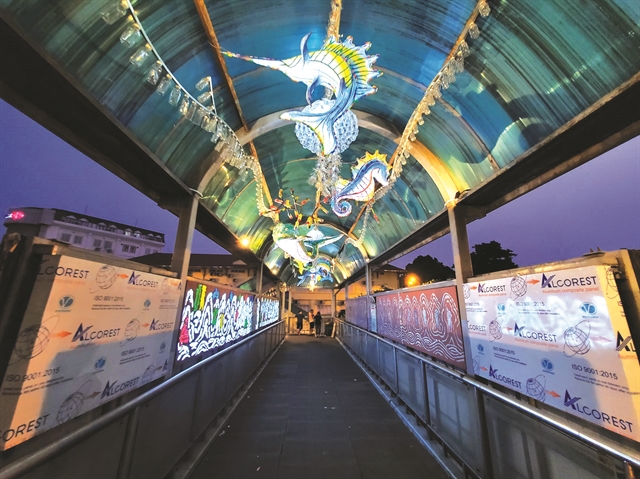
The public art project on the Trần Nhật Duật pedestrian bridge in Hoàn Kiếm (Hà Nội). VNA/VNS Photo
Since joining UNESCO’s Creative Cities Network in 2019, Hà Nội has embarked on a journey to redefine its cultural identity and position creativity as a driving force for growth.
Over the past five years, both local residents and the nation as a whole have increasingly recognised the importance of innovation in shaping the capital's evolving cultural landscape.
The city is not just preserving its rich cultural and historic heritage, but also leading the way in fostering creative values. It has set a model for other Vietnamese cities by blending tradition with modern creativity to chart a new cultural path.
Establishing a creative identity
Hà Nội joined the UNESCO Creative Cities Network under the category of design in October 2019. This affiliation was significant, as it provided the city with a global platform to showcase its creative potential.
However, soon after joining, the city encountered an unforeseen challenge—the outbreak of COVID-19, which disrupted many of its plans and initiatives. Despite these obstacles, the city took proactive measures to foster creativity and development, introducing various plans, mechanisms, and policies aimed at affirming its role as a "Creative City".
One of the prime examples of this creative transformation is the Trần Nhật Duật pedestrian bridge, which connects the Phúc Tân Public Art Project to Hà Nội’s Old Quarter. The bridge offers more than just a physical link—it provides a unique sensory experience, featuring illuminated installations reminiscent of an aquarium. The vivid depictions of fish, Red River waves, and other aquatic motifs, crafted from recycled materials, highlight the city’s commitment to blending creativity with sustainability.
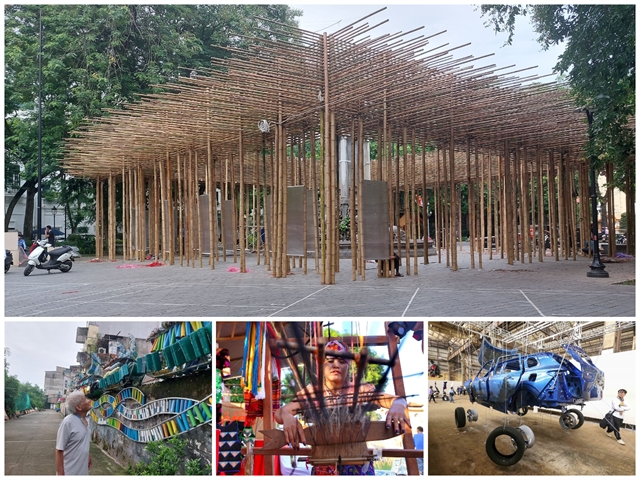
MONTAGE: Hà Nội city is not just preserving its rich cultural and historic heritage, but also leading the way in fostering creative values. VNA/VNS Photos
Another example of the city's creative expansion is the Centre for Vietnamese Craft Quintessence in Bát Tràng on the outskirts district of Gia Lâm, located about 15km from the pedestrian bridge. The centre, with its striking architecture inspired by the potter's wheel, has become a magnet for both local and foreign tourists.
It serves multiple functions, offering spaces for shopping, and cultural activities, while simultaneously promoting traditional Vietnamese pottery and craftsmanship. This fusion of traditional and contemporary design reflects the city’s efforts to create a diverse and inclusive cultural landscape.
The term "creative spaces" may be relatively new in Việt Nam, but the spirit of creativity has long been embedded in Hà Nội’s ethos. An example of this is the Vụn Art Cooperative, tucked away in Vạn Phúc Silk Village (Hà Đông District).
Established in 2017, Vụn Art has created a unique space that supports people with disabilities by providing stable jobs and a platform to showcase their creativity. The cooperative uses scrap fabric to make intricate collages, hand bags, wallets, and clothing, turning waste into art while promoting sustainability.
Lê Việt Cường, the founder of Vụn Art Cooperative, has big plans for expanding the model. He envisions enabling people with disabilities to work from home, collaborating with domestic fashion brands, and creating new practical products that will enrich the city's tourism offerings. This cooperative is just one of the many initiatives contributing to Hà Nội's growing reputation as a 'creative hub'.
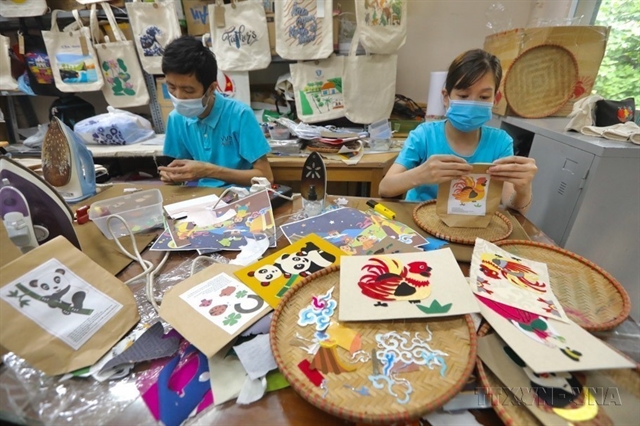
Leftover fabric has been given new life as unique products crafted by the hands of workers with disabilities at Vụn Art Cooperative. VNA/VNS Photo
Currently, Hà Nội boasts 124 creative spaces across the city. They include well-known locations like the Hoàn Kiếm Walking Street, the Phùng Hưng mural project, the Việt Nam Fine Arts Museum, and cultural architecture at Hà Nội Museum.
The city has also seen the transformation of industrial sites into cultural and recreational spaces, underscoring the demand for creative hubs among the younger generation.
Among them is the former Gia Lâm Railway Factory, which was converted into a community art space during the Hà Nội Creative Design Festival 2023. The event attracted over 200,000 visitors and hosted 20 cultural activities, reflecting the city's vibrant and flourishing creative scene.
Phạm Thị Thanh Hường, chief of culture at the UNESCO Office in Việt Nam, praised the city for building a robust network that connects creative professionals, spaces, and industry associations. She noted that Hà Nội’s efforts serve as a model for other cities looking to cultivate their own creative environments.
Cultivating a creative atmosphere
Since joining UNESCO’s Creative Cities Network, the city has initiated a wide range of design-related competitions and public events, such as "Creative Space Design Hà Nội", "Designing Km Zero", and "Public Art Design Hà Nội".
These initiatives have led to the development of new pedestrian streets and cultural spaces like Trịnh Công Sơn Walking Street, Sơn Tây Ancient Citadel Walking Street, and Trần Nhân Tông Walking Street at Thống Nhất Park. Spaces like 22 Hàng Buồm and Phúc Tân Public Art Space are further contributing to the cultural vibrancy of the city.
In addition to these public spaces, annual events such as the Hà Nội Creative Design Festival, Folk Culture Festivals in Contemporary Life, and Creative Source Week are regularly organised to engage the community.
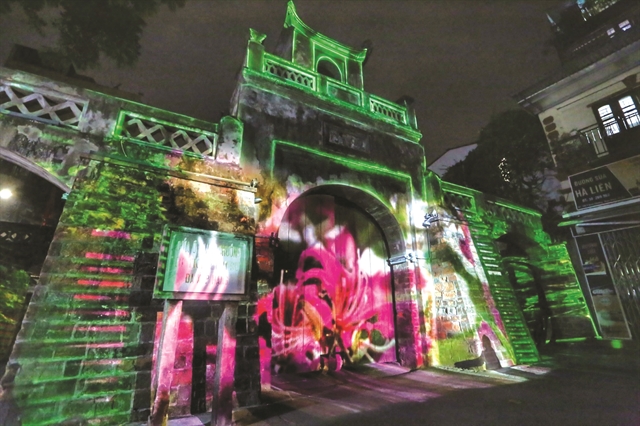
VIBRANT: A visual art performance of 3D mapping at Quan Chưởng Gate in the Old Quarter area.
The events feature a wide range of activities, from cultural discussions and exhibitions to performances and interactive experiences. Through the initiatives, Hà Nội has successfully raised public awareness about the value of creativity and innovation in city development.
Phạm Thị Lan Anh, head of Cultural Heritage Management at Hà Nội’s Department of Culture and Sports, highlighted the importance of educating the public about the concept of a Creative City.
She noted that many people were initially unsure about what joining the Creative Cities Network entailed and questioned whether the benefits outweighed the costs. However, through ongoing educational efforts, Hà Nội had gradually changed public perception and paved the way for broader participation in the city's creative initiatives.
Hà Nội’s creative potential
Being both the "Heroic Capital" and a "City for Peace", Hà Nội’s cultural depth is rooted in its millennia-old heritage. This provides a strong foundation for the city to further develop as a "Heritage City." Combining this historical identity with its new status as a "Creative City" offers a unique opportunity for transformative growth.
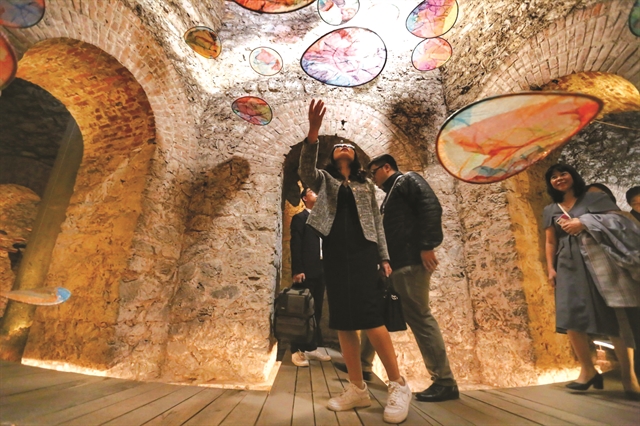
The Hàng Đậu water tower, a historic relic of colonial architecture in Hà Nội, has been converted into an installation art space. VNA/VNS Photo
According to Associate Professor and Doctor Nguyễn Chí Bền, a member of the Intangible Cultural Heritage Council, while fostering new creativity is essential, it is equally important to focus on traditional creativity. Hà Nội is home to multiple traditional festivals and craft villages, which represent the cultural backbone of the city.
Bền believes that by revitalising traditional festivals and promoting creative models in craft villages, the city can solidify its position as the creative capital of Việt Nam.
Industry development
As the first city in Việt Nam to join the UNESCO Creative Cities Network, Hà Nội has faced a steep learning curve, and some objectives remain unmet. However, the revised Capital Law, set to take effect on January 1, 2025, is expected to provide a much-needed boost to the city's creative sector.
The law introduces specific mechanisms and policies designed to foster the growth of the city's cultural industries, while also overcoming obstacles that have hindered progress in the past.
The Hà Nội Communist Party Committee issued Resolution 09 in 2022, outlining a strategic vision for developing the capital's cultural industries between 2021 and 2025, with long-term orientations extending to 2045.
The resolution aims to position Hà Nội as an Asian-standard Creative City and elevate cultural industries as a key economic driver.

IN PROGRESS: The Hà Nội Children's Palace project is expected to open its doors in late 2024. It it located in Cầu Giấy-Nam Từ Liêm new urban area, and covers nearly 40,000sq.m.
Director Phạm Hoàng Nam has recognised this shift in awareness, stressing the need to fully understand and leverage cultural capital while establishing supportive policies.
The revised Capital Law is expected to address many long-standing challenges by providing a stronger legal framework that supports cultural and creative industries. Key provisions of the law include unique policies for establishing cultural industry centres, allowing more flexible regulations for public-private partnerships in the culture industry, and improving the management of public assets.
For cultural workers and businesses in the city, the law is seen as a significant motivator, opening new opportunities for development.
Creativity is not just a tool for cultural expression – it is a driver of economic development and social harmony. To harness the full potential of the city’s creative sector, investment must be carefully targeted, based on thorough research into public needs and real-life contexts. This includes enhancing art education across the city to cultivate creativity from a young age.
"Art education is not merely about producing artists; it’s about fostering an appreciation for beauty and a love for creativity. This way, we nurture creative citizens in an enterprising nation," said Assoc. Prof. Bùi Hoài Sơn.
The revised Capital Law is expected to empower cultural officers in the city to implement creative initiatives with greater freedom. However, the success of these initiatives will depend on the expertise and creativity of the officers themselves. Many experts believe that additional training programmes, aligned with sectoral strategies and goals, are essential for cultivating the next generation of cultural leaders.
Moreover, experts have proposed the establishment of a steering committee and a project management board to integrate cultural industry development with creative innovation. Similar models exist in fields such as transport, construction, and sci-tech, but have yet to be applied to the cultural sector.
In the coming years, the city's focus must remain on fostering creativity in all sectors, from cultural industries to technology and public innovation. By doing so, the city can ensure that creativity becomes a core element of its cultural identity, guiding Hà Nội towards a sustainable and prosperous future. VNS
OVietnam